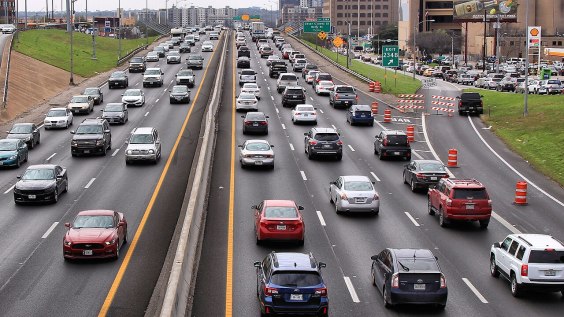 Intersection of Guerrero St and San Jose Ave, site of a new 9,000 sf plaza. Photo: Matthew Roth
Intersection of Guerrero St and San Jose Ave, site of a new 9,000 sf plaza. Photo: Matthew RothWhen Mayor Gavin Newsom dedicated the first of three Pavement to Parks plazas at 17th and Market streets, he promised to push forward with the next two trial plazas in short order, including one at the intersection of Guerrero Street and San Jose Avenue, one of the more precarious corners in the city, where traffic speeds down Guerrero after exiting I-280, the footprint of the now-abandoned Mission Freeway. For community residents like Gillian Gillett, who has been fighting to make the neighborhood more pedestrian friendly and less sick with dangerous traffic for years, the news was thrilling.
"It's a real impediment to rational urban life the way it's existed," said Gillett, a software programmer, who explained that she first became active around traffic and transportation issues when she was pregnant with her daughter in 2001. Before she and her neighbors took a stand, she said her street was the iconic high-traffic artery as explained in Donald Appleyard's seminal study on cars and community, a street that tore the neighborhood apart and kept neighbors from meeting each other or spending any time in public space together.
"I was really pissed off when I was pregnant and couldn't cross the
street," said Gillett. "I was offended that the city would operate that way."
Through her community group San Jose/Guerrero Coalition to Save Our Streets, Gillett first tried to calm the intersection of Guerrero and Cesar Chavez, where the city had a triple left-turn lane configuration from westbound Cesar Chavez to southbound Guerrero, followed by three wide traffic lanes and eight unsignalized intersections, which led to rampant speeding and more than a few car-in-house crashes.
 Gillian Gillett with her daughter. Photo: MTC
Gillian Gillett with her daughter. Photo: MTC"Of the 12 houses on the 1450 block of Guerrero at Cesar Chavez, 9 of them have been run into by cars, several of them repeatedly," explained Gillett. Like Appleyard's other victims of heavy traffic, she and her neighbors always kept their windows facing Guerrero closed and lived and slept in the back of their houses, where they could find the most serenity.
Unfortunately, she related, one weekday morning at 6:30 am, one of their neighbors was stabbed 10 times on the sidewalk on Guerrero. No one could hear his screams over the noise of traffic and none of the motorists stopped or called the police. The man died there on the sidewalk, just blocks from St. Luke's Hospital.
"I had heard so many horror stories about traffic. These are people who
didn't let their kids out on the street because cars were crashing into
their houses," Gillett said. The SFPD didn't understand how bad the
issue was until she demanded former Ingleside Station Captain Kevin Dillon
come down to her home with a speed gun.
"When
I was pregnant I brought Captain Dillon down here and he
dutifully brought his radar gun down and measured speeds at 62 miles
per hour. He said, 'Oh lady, we could be out here writing tickets all
day, but it wouldn't solve your problem. You have an engineering
problem.'"
Gillett and the coalition have applied for and received numerous grants to aid their work, including a $75,000 Transportation for Livable Cities (TLC) grant through the Metropolitan Transportation Commission (MTC) for a community plan. In early 2005, the community got its first road diet when the MTA narrowed Guerrero from three lanes in each direction to two and added a bicycle lane. As a result of this and other traffic calming measures, dedicated pedestrian enforcement stings from the SFPD, and new traffic signals, Gillett explained, the collision rate for the 11 blocks on Guerrero between Cesar Chavez and Randall St. has been reduced by 53 percent since 2004.
The New Plaza
 A sketch of the proposal for a plaza at the intersection of San Jose and Guerrero. One lane at the eastern edge of the plaza (bottom of picture) will receive the same pavement treatment as the plaza, but remain open to local traffic so the seven driveways belonging to residents along the street can be accessed. Copyright 2009 Shift Design Studio
A sketch of the proposal for a plaza at the intersection of San Jose and Guerrero. One lane at the eastern edge of the plaza (bottom of picture) will receive the same pavement treatment as the plaza, but remain open to local traffic so the seven driveways belonging to residents along the street can be accessed. Copyright 2009 Shift Design StudioGillett and other members of the community have long had their eye on the roughly 9,000 square feet
of marginally used asphalt on the east side of the awkward intersection
of San Jose, Guerrero, and 28th Street. Using the TLC grant from 2005, they hired Project for Public Spaces (PPS) in New York City to help them envision a more humane treatment for the intersection and better use of the public realm.
With Mayor Newsom's apparent new zest for reclaiming under-utilized streets and turning them into public space, the community vision is well on the way to realization.
"The vision of the
space is to provide more of a park-like element, provide open space for
the neighbors," said Andres Power of the Planning Department, who has been tasked with developing a plaza design and implementing the trial closure by early September so the plaza will be open on Labor Day. Like the plaza at 17th Street, the city is scouring its supply yards for extra supplies.
"The idea is to emphasize greenery and a strong
delineation between the roadway and the space," said Power, who expressed concern about the noise and disruption that heavy traffic could continue to have despite their best efforts.
Gillett is working with local property owners around the plaza to try
to attract more family-focused businesses. The one active retail use
immediately adjacent to the plaza is Cup O' Java on the west side of
Guerrero. Mitchell's Creamery, a destination that attracts people from
around the city and has notoriously long lines down the sidewalk, is one
block south on Guerrero. Immediately on the plaza, there is a vacant retail space that Gillett would love to see rented by a childcare facility.
Gillett said that through community surveys they commissioned with their TLC grant, they discovered that the neighborhood is home to a high proportion of software developers. Two of them who live in the "Peach House" featured in the background of the picture above have taken it upon themselves to be sure the plaza will have a strong WiFi signal.
For the plaza design, architect and landscape designer Jane Martin, founder of Plant SF and principal of Shift Design Studio, who Gillett joked is competing with her and her Greening Guerrero project to see who can de-pave San Francisco faster, is donating her time on the project (Martin on the depaving competition: "She's got a ways to go to catch up with me").
"The concept that I have is to take this sea of
asphalt and make it somehow habitable," said Martin, who explained that her inspiration is based on a history she read of Golden Gate Park, where engineer William Hammond Hall was tasked with figuring out how get plants to grow out of arid sand dunes. "Hall knew If he could get the bush lupine to grow, he could get shrubs to grow,
then trees after that."
Martin said that Hall couldn't get the lupine or anything else to grow until he observed that the barley he fed his draft horses would take root in the sand after a few days. Once he sowed the barley, lupine followed suit, then grasses, and finally the trees that are in the park to this day.
When Martin was granted access to the city's "boneyards" to find supplies for the plaza, she discovered that many of Hall's original trees had fallen or were being taken out and sent to the compost yard. "They
are unceremoniously being turned into mulch," she said.
Martin has taken several of the original Golden Gate Park tree trunks and plans to hollow them out to turn them into planters that will serve as the boundary between the plaza and traffic on Guerrero. "They are a piece of
nature that can lay claim to this vast amount of asphalt." In addition, she plans to rip up the cement in the middle of the two islands that currently exist and plant them. Because there are no curb-cuts in the islands, they are already useless for persons with disabilities or parents with strollers.
With so many families in the neighborhood and scant open space, the plaza will have a special focus on children, with elements designed to evoke a playground. "I really want to pay homage to the horse,"
explained Martin, who plans to install several playground horses on
springs facing west, so they appear ready to ride to the ocean.
Assuming the plaza is successful and the city decides to make it permanent, Martin would like to name it after Hall's horse, though she said she couldn't find any record of the horse's name in the Golden Gate Park history she was reading.
"I've got researchers looking into
finding out the name of the horse, but we haven't found it yet," she said. "If we can't find it, we'll just call it "Hall's
Horse Park."
 The PPS sketch the community developed for San Jose and Guerrero. The trial plaza will implement similar treatments for the plaza portion at the right. Gillett and the community hope it will lead to permanent pedestrian treatments, such as high-visibility crosswalks, a traffic signal, and bulb-outs. Courtesy: PPS
The PPS sketch the community developed for San Jose and Guerrero. The trial plaza will implement similar treatments for the plaza portion at the right. Gillett and the community hope it will lead to permanent pedestrian treatments, such as high-visibility crosswalks, a traffic signal, and bulb-outs. Courtesy: PPS



